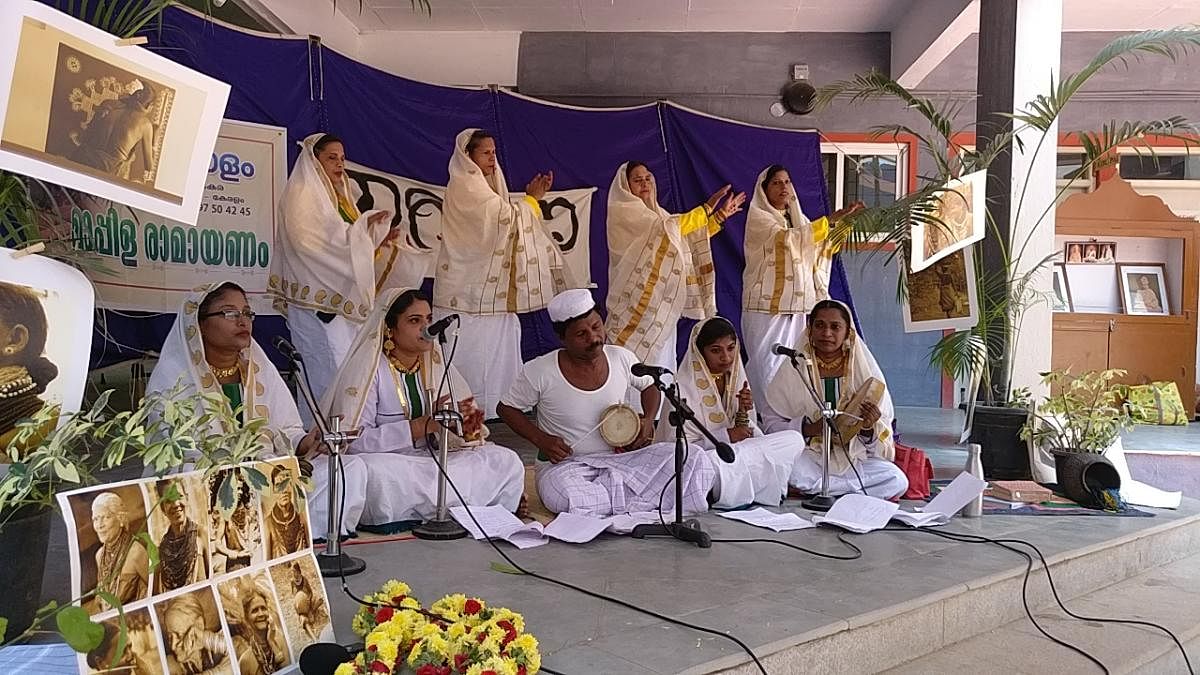Testimony to confluence of cultures

Valmiki wrote the fascinating story of Ramayana in Sanskrit, which is the oldest version of Ramayana—Valmiki Ramayana. But he would not have found the need to think about the language and culture barriers to the spread of the epic among the populace.
But popular cultures have their own way of dealing with this through folklore, to share stories and traditions from generation to generation. The result could be a ‘Lama’ who quotes the laws of Shariat to escape from Shurpanakha, or a selfish Rama who depends on Lakshmana for everything. Stories and focus differ depending on the narrators too.
Ragi Kana, a cultural hub and Sunday market in Bengaluru organised by Graama Seva Sangha, provided a platform for the performance of two such versions of Ramayana: Seethe kami and Mapilla Ramayana, recently.
The feminist version
Savita Uday and volunteers from BuDa folklore brought a hidden folk version of the Ramayana from the Halakki tribes of Uttara Kannada district. Padmavathi along with Savita presented the story to the urban audience not much accustomed to varieties in epics.
Dr Savita says, Padmashri Sukri Bomma Gowda (fondly known as Sukrajji) used to tell this story and as a kid, she used to listen to it. Halakki tribes have strong womenfolk who bind the families together, and also work hard in the fields and forest. And Seethe Kami emphasises more on Seetha, not so much on Rama.
In their story, Seetha is the daughter of Mandodari and Ravana. Her horoscope predicts that Seetha is not lucky for Ravana. Ravana asks Mandodari to kill the baby, cook and feed him. But Mandodari leaves the baby near the pond in King Janaka’s palace premises. The story narrates how she cooks a rabbit and feeds Ravana, and participates in all the jokes that Ravana utters about it.
Uttara Kannada region even today has a saying: ‘Seethe hutti Lankege kedu’ (The birth of Seetha was a misfortune for Lanka) — which might have its roots in this version of Ramayana.
The Halakki tribes treat frogs as Mandodari. Mandodari is also born from the earth. When frogs enter homes in the rainy season, they say ‘Mandodari came home.’ Incidentally, frogs are called Mandooka in Sanskrit.
The version of Halakki tribes may not be original, for, Seetha is the daughter of Ravana even in Sanghadasa’s Jaina version of Ramayana and in Adbhuta Ramayana. According to these versions, astrologers predict that the first child of Ravana will destroy his lineage, therefore he wants her to be killed. But Seetha ends up in Janaka’s premises due to either a kind ‘Mantri’ or a soldier.
What makes it different is that the characters in the story are not superficial or god-like, they do all the chores a normal human being would do. Seetha washes clothes in the pond, Dasharatha chews betel leaves and chats. Rama is a selfish, doubtful, painful elder brother who depends on Lakshmana for everything. There is no ‘swayamvara’ — King Janaka says whoever kills the crow troubling him will get Seetha and half of his kingdom. All these elements bring Ramayana closer to people, which is otherwise treated as a sacred superficial epic.
Savita says, the songs passed on from generation to generation in the form of folklore are now being lost, and there are not too many people who can now sing Seethe kami.
There are different types of Ramayana in other tribes of Uttara Kannada as well. BuDa folklore, an organisation focussing on folklore research and folk culture, based in Honnavar, Uttara Kannada, has documented many of them.
A cross-cultural epic
Mapillas are Malabari Muslims who are traditionally into small-time trade and fishing. Nobody knows who wrote the verses of Mapilla Ramayana in Malayalam. But what’s interesting is the way they are sung in Mapilla Paattu style, and the localisation of the characters, their names etc, and the satire and comedy played out in the story.
In Mapilla Ramayana, Rama is pronounced as ‘Lama’, and Hanuman is ‘Anuman’. Kaikeyi, Rama’s aunt, becomes ‘elemma’, while Malabari Muslims call their aunts ‘ilayamma’.
‘Sultan’ Lavana, in Mapilla Ramayana, struggles to shave his ten beards. Shurpanakha has a friend called Fathima, who helps her apply charcoal to her teeth to brighten it, and get ready to meet Lama.
The reference to laws of Shariat appears in the conversation between Shurpanakha and Lama. Lama quotes the laws of Shariat to reject her advances. Shurpanakha also quotes the same laws of Shariat to convince Lama about marrying her.
Mapilla Ramayana is a testimony to the Hindu-Muslim camaraderie and confluence of cultures prevalent in coastal Kerala once upon a time. However, now there are not too many groups singing this—the performances of Mapilla Ramayana are fading fast under pressure from fundamentalists on both the sides—Hindus and Muslims.
Currently, a group of artistes from Vadakara in Kerala, led by Ashalatha, is performing the Mapilla Ramayana on invitation. She has introduced a performance element to the songs, where four women dance in Mapilla ‘Oppana’ style clapping their hands, while others sit and sing the verses. There are other such small groups, but the demand for such performances is reducing.
Their performance at Ragi Kana left the audience tapping their feet to the rhythm of the songs while those who understood Malayalam enjoyed the nuances in the story as well.
According to Ashalatha, there is only one motive behind the performances of Mapilla Ramayana: the sheer love towards the lyrics, art and performance.
Deccan Herald is on WhatsApp Channels| Join now for Breaking News & Editor's Picks